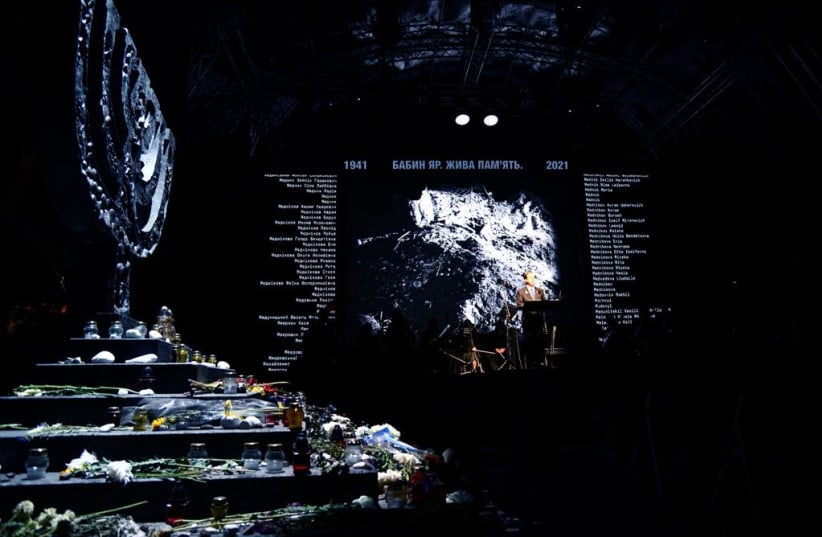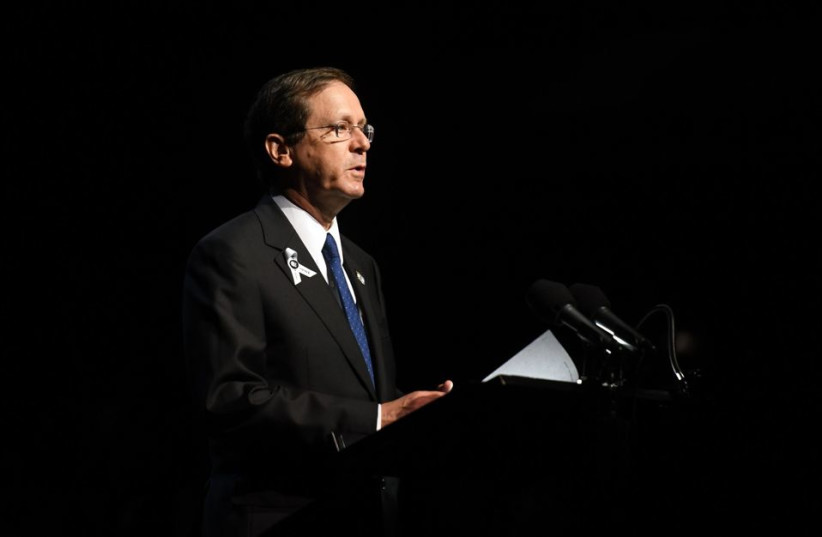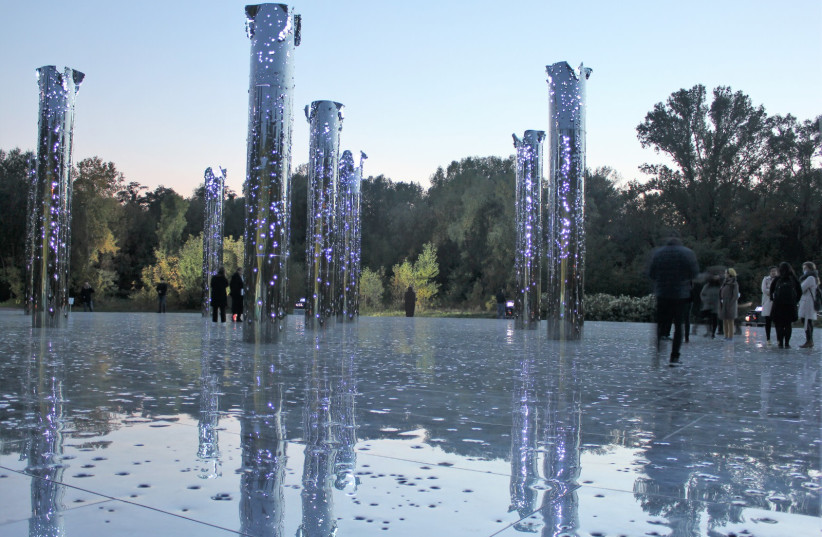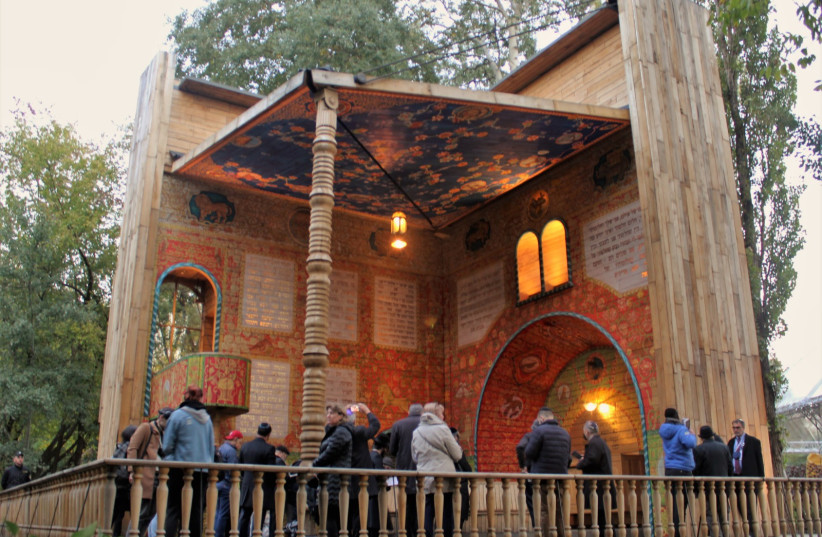KYIV – The presidents of Ukraine, Israel and Germany on Wednesday led an inauguration ceremony of a memorial site at Babyn Yar in the Ukrainian capital, Kyiv, a site where 80 years ago at least 33,771 Jews were executed by Nazis and their collaborators and buried in a ravine over a period of 48 hours on September 29-30, 1941.
As many as 150,000 people – Ukrainians, Roma, Soviets and the physically and mentally disabled – were murdered over a longer period, making it Europe’s largest mass grave.
The Babyn Yar site is currently a suburban public park where children play and people may sit on a bench to enjoy a few beers, and aside from a few monuments that can easily be overlooked, there is little to suggest that the verdant area was the site of the largest mass murder in Europe, where the Nazis perpetrated some of their most brutal crimes.
The Soviet regime under Stalin then added another layer of criminality by trying to erase the memory of what happened at Babyn Yar (Babi Yar in Russian), suppressing the terrible plight of the Jews because of the complicity of some of its own citizens in the shootings.
Presidents Isaac Herzog, Volodymyr Zelensky of Ukraine and Frank-Walter Steinmeier of Germany attended, alongside the private funders of the project and a number of prominent figures, current and former politicians and leaders of Jewish communities and others.
They launched the massive memorial project that is set to change the face of the park and will undoubtedly reinvigorate the memory of the Holocaust, which otherwise could fade fast as the last survivors of the period disappear and with them firsthand accounts.
The dignitaries’ speeches were interspersed by symbolic musical performances, including the centerpiece that began the event, Dmitri Shostakovich’s Symphony No. 13, “Babi Yar.”
Probably the 20th century’s most important symphonist used the poems of fellow Soviet Yevgeny Yevtushenko in his work of 1962. Yevtushenko revived the memory of what happened at the site in his epic poem published a year earlier after Nikita Khrushchev slightly relaxed the megalomaniac iron grip of Stalin on internal freedom of speech in the Soviet Union.
The powerful work hits hard, and the words sung by bass and choir accompanied by a full orchestra invoke the dark times of the Second World War. Shostakovich himself was besieged in Leningrad and had firsthand experience of the horrors of the war.
World-renowned violinist Gideon Kremer and cellist Mischa Maisky were among the other performers.
In his speech at the ceremony Herzog said: “On the soil of Ukraine, for centuries there flourished one of the greatest and most important Jewish communities in the world... And here there were also terrible pogroms against Jews throughout the ages. Here, too, was the Babi Yar Massacre. A formative event and a chapter that must never be erased from the annals of the family of nations. An eternal scar on the surface of our planet.”
Zelensky said: “In this place it is hard to breathe, in this place more than 100,000 people were executed. It’s hard to stand here. If there is a place that has been forsaken by God and the devil has infiltrated, it is here, in Babi Yar.”
The memorial site stretches over a 150-hectare area and includes two current exhibits, “Crystal Wall of Crying” by conceptual and performance artist Marina Abramovic and “Mirror Field”: a large platform with a shiny metal floor and 10 chrome-plated pillars riddled with bullet holes of the same caliber as those that the murderers used in their weapons. A wooden synagogue that can be folded shut like a book is also on the site.
The first stage of the project is due to be completed this year, although the main memorial and museum are still either under construction or in the planning stages and will be completed in only a few years.
Earlier on Wednesday, the Babyn Yar Holocaust Memorial Center (BYHMC) released the testimonies of 159 of some of the perpetrators of the shootings, including one by Nazi soldier Viktor Trill, who recounted: “It is possible that on this day I shot between 150 and 250 Jews. The whole shooting went off without incident. The Jews were resigned to their fate like lambs. After we got out, first we were given alcohol. It was grog or rum. I then saw a gigantic ditch [ravine] that looked like a dried-out riverbed. In it were several layers of corpses.
“The execution began first with a few members of our Kommando going down into the ravine,” he said.
“At the same time, about 20 Jews were brought along from a connecting path. The Jews had to lie down on the corpses and were then shot in the back of the neck. More Jews were continually brought to be shot.”
War crimes investigator and Babyn Yar academic head, Father Patrick Desbois, wrote in an introduction to the lengthy press release containing the killers’ accounts and said: “Some were shooters, others extracted the Jews from their homes, others took their belongings, or served sandwiches and tea to the shooters. All of them are guilty.”
Due to the Nazis’ meticulous documentation, the number of Jews shot dead at the Babyn Yar ravine by Einsatzgruppen troops and their collaborators in those 48 hours at the end of September 1941 is known. Later, in order to remove the evidence, the Nazis used slaves who, over a period of some two months, unearthed the bodies, which were taken away and burned.
An academic task group of the BYHMC set up to identify those who participated in the massacre estimate that hundreds of German soldiers, policemen and SS-personnel, and their collaborators, were involved.
Natan Sharansky, who chairs the BYHMC’s supervisory board, said the aim of the new center would be to reinvigorate the memory of a crime that was covered up twice.
“Babi Yar is the symbol of a double crime. It is the symbol of the Nazis’ crime – the biggest Holocaust mass grave in Europe – and it is a crime of the Soviet regime, which did everything it could to erase the memory of Babi Yar physically, and to wipe the memory of the Holocaust from the pages of history,” he said.
“We now want to turn this place into a symbol of the crimes of the Nazis and a symbol of the Soviet efforts to erase the memory of the Holocaust: to establish a museum, an information center, a study center,” Sharansky said at a news conference in Kyiv ahead of the ceremony.
Desbois said that contemporary perpetrators of mass killing should take heed of the memorial site’s establishment.



